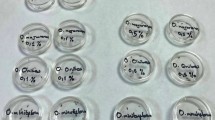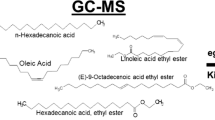Abstract
The present study shows that head lice (Pediculus humanus capitis) are killed by suffocation when submersed into the anti-louse shampoo Licener®, which contains a mild shampoo component and an extract of neem seeds after their oil components had been pressed off. It is shown that the inner tracheal system becomes completely filled by the very fluid product. Within 3–10 min, oxygen uptake is prohibited and death of all thus treated lice stages occurred.









Similar content being viewed by others
References
Abdel-Ghaffar F, Semmler M, Al-Rasheid KAS, Klimpel S, Mehlhorn H (2010) Comparative in-vitro test on the efficacy and safety of 13 anti-head-lice products. Parasitol Res 106:423–429
Abdel-Ghaffar F, Al-Quraishy S, Al-Rasheid KAS, Mehlhorn H (2012) Efficacy of a single treatment of head lice with a neem seed extract: an in vitro study on nits and motile stages. Parasitol Res 110:277–280
Bonilla DL, Kabeya H, Henn J, Kramer VL, Kosoy MY (2009) Bartonella quintana in body lice and head lice from homeless persons, San Francisco, California, USA. Emerg Infect Dis 15:912–915
Burgess IF (2004) Human lice and their control. Ann Rev Entomol 49:475–481
Burgess IF (2005) Current treatments for pediculosis capitis. Curr Opinions Infectious Dis 22:131–136
Clark JM (2009) Determination, mechanism and monitoring of knockdown resistance in permethrin-resistant human head lice (Pediculus humanus capitis). J Asian Pacific Entomol 12:1–7
Combescot-Lang C, Stichele RHV, Toubate B, Veirron E, Mumcuoglu KY (2015) Ex vivo effectiveness of French over the counter products against head lice (Pediculus humanus capitis De Geer, 1778). Parasitol Res 114:1779–1792
Coz J, Combescot-Lang C, Verdier VC (1993) Resistance of head lice Pediculus capitis to pyrethroids: d-phenotrin and permethrin in France. Bull Soc Fr Parasitol 11:245–254
Downs MR, Harvey I, Kennedy CT (1999a) The epidemiology of head lice and scabies in the UK. Epidemiology and Infection 122:471–477
Downs AMR, Stafford KA, Harvey I, Coles GC (1999b) Evidence for double resistance to permethrin and malathion in head lice. Br J Dermatol 141:508–511
Downs AMR, Stafford KA, Hunt LP, Ravenscroft JC, Coles GC (2002) Widespread insecticide resistance in head lice to the over-the counter pediculocides in England, and the emergence of carbaryl resistance. Br J Dermatol 146:88–93
Durand R, Millard B, Bouge-Michel C, Bruel C, Bouvresse S, Izri A (2007) Detection of pyrethroid resistance gene in head lice in school children from Bobigny, France. J Med Entomol 44:796–798
Falagas M, Matthaiou D, Rafailidis P, Panos G, Pappas G (2008) Worldwide prevalence of head lice. Emerg Inf Dis 14:1493–1494
Gao JR, Yoon KS, Frisbie RK, Coles GC, Clark JM (2006) Esterase-mediated malathion resistance in the human head louse, Pediculus capitis (Anoplura: Pediculidae). Pestic Biochem Physiol 85:28–37
Gur I, Schneeweiss R (2009) Head lice treatments and school policies in the US in an era of emerging resistance. A cost effectiveness analysis. Pharmacoeconomics 27:725–734
Heukelbach J, Oliveira FA, Speare R (2006) A new shampoo based on neem (Azadirachta indica) is highly effective against head lice in-vitro. Parasitol Res 99:353–356
Hunter JA, Barker SC (2003) Susceptibility of head lice (Pediculus humanus capitis) to pediculicides in Australia. Parasitol Res 90:476–478
Kristensen M (2005) Identification of sodium channel mutations in human head louse. J Med Entomol 42:826–829
Kristensen M, Knorr M, Rasmussen AM, Jespersen JB (2006) Survey of permethrin and malathion resistance in human head lice populations from Denmark. J Med Entomol 43:533–538
Lebwohl M, Levitt J (2007) Therapy for head lice based on life cycle, resistance and safety consideration. Pediatrics 119:965–974
Mehlhorn H (2011) Head lice and their control. A long lasting story. In: Preedy VR (ed) Handbook of hair in health and disease. Wageningen Academic Publishers, pp 355–386
Mehlhorn H (ed) (2015) Encyclopedia of Parasitology, 4th edn. Springer, Heidelberg
Meinking TL (1999) Lice infestations. Curr Problems Dermatol 11:73–118
Meinking TL, Vicaria M, Eyerdam DH, Villar ME, Reyna S, Suarez G (2007) A randomized, investigator-blinded, time-ranging study on the comparative efficacy of 0.5% malathion gel vs Ovide® lotion (0.5% malathion) or Nix crème rinse (1% permethrin) used as labeled, for the treatment of head lice. Pediatric Dermatol 24:405–411
Mougabure-Cueto G, Zerba E, Picollo MI (2008) Evidence of pyrethroid resistance in eggs of Pediculus humanus capitis (Phthiraptera: Pediculidae) from Argentina. J Med Entomol 45:693–697
Mumcuoglu KY (1999) Prevention and treatment of head lice in children. Pediatrics and Drugs 1:211–218
Mumcuoglu KY, Gilead L, Ingber A (2009) New insights in pediculosis and scabies. Expert Review Dermatol 4:285–302
Nair B (2003) Cosmetic ingredient expert panel - final report on safety assessment. Int J Toxicol 22:11–35
Robinson D, Leo N, Provic P, Barker S (2003) Potential role of Pediculus humanus capitis as vectors of Rickettsia prowazekii. Parasitol Res 90:209–211
Sasaki T, Poudel S, Isawa H, Hayashi T, Sekia N, Tomita T, Sawabe K, Kobayashi M (2006) First molecular evidence of Bartonella quintana in Pediculus humanus capitis (Phthiraptera: Pediculidae), collected from Nepalese children. J Med Entomol 43:110–112
Schmutterer H (2002) The neem tree. Sources of unique natural products for integrated pest management, medicine, industry and other purposes, 2nd edn. Neem Foundation, Mumbai
Semmler M, Abdel-Ghaffar F, Al-Rasheid K, Klimpel S, Mehlhorn H (2010) Repellency against head lice (Pediculus humanus capitis). Parasitol Res 106:729–731
Toloza AC, Vassena C, Gallardo A, Gonzalez-Audino P, Picollo MI (2009) Epidemiology of pediculosis capitis in elementary schools of Buenos Aires, Argentina. Parasitol Res 104:1295–1298
Toloza AC, Lucia A, Zerba E, Masuh H, Picollo MI (2010) Eucalyptus essential oil toxicity against permethrin resistant Pediculus humanus capitis. Parasitol Res 106:409–414
Vassena CV, Mougabure-Cueto G, Gonzalez Audino P, Alzogaray R, Zerba E, Picollo MI (2003) Prevalence and levels of permethrin resistance in Pediculus humanus capitis De Geer (Anoplura: Pediculidae) from Buenos Aires, Argentina. J Med Entomol 40:447–450
Yoon KS, Gao J, Lee SH, Coles GC, Meinking T, Taplin D, Edman J, Tacano-Lee M, Clark JM (2004) Resistance and cross resistance to insecticides in human head lice from Florida and California. Pestic Biochem Physiol 80:192–201
Acknowledgement
The authors extend appreciations to the Deanship of Scientific Research at King Saud University for funding the work through the international research group project IRG14-23.
Author information
Authors and Affiliations
Corresponding author
Rights and permissions
About this article
Cite this article
Al-Quraishy, S., Abdel-Ghaffar, F. & Mehlhorn, H. Head louse control by suffocation due to blocking their oxygen uptake. Parasitol Res 114, 3105–3110 (2015). https://doi.org/10.1007/s00436-015-4528-6
Received:
Accepted:
Published:
Issue Date:
DOI: https://doi.org/10.1007/s00436-015-4528-6




